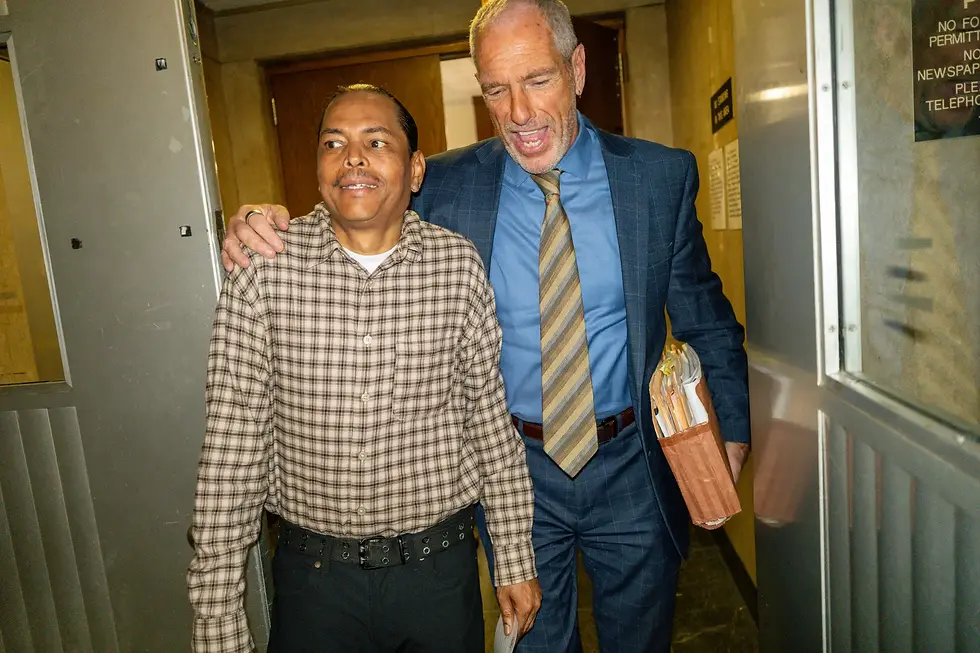In Trial of Rikers Officers, Focus Turns to Cover-Up of an Inmate’s Beating
- Winnie Hu
- Mar 28, 2016
- 3 min read
By Winnie Hu New York Times March 28, 2016
Dwayne Maynard was not one of the five correction officers accused of mercilessly beating Jahmal Lightfoot, an inmate at Rikers Island, to teach him a lesson.
But it was Officer Maynard who was on trial in New York State Supreme Court in the Bronx on Monday as opening statements continued for a second day in the case of nine current or former Rikers correction officers accused of taking part in what prosecutors have described as an orchestrated assault and cover-up in July 2012.

Officer Dwayne Maynard is among three correction officers at Rikers Island accused of covering up a brutal attack on inmate
in July 2012.Credit...Bryan R. Smith for The New York Times
“He should not be here, not as a defendant,” Frank Rothman, a lawyer for Officer Maynard, said in his opening before Justice Steven Barrett. “He should be here as a spectator in the audience, if anything.”
Officer Maynard and two other correction officers, Harmon Frierson and Jeffrey Richard, have been charged only in connection with the cover-up. Prosecutors said that the men, while they did not physically beat Mr. Lightfoot, later tried to help cover up the attack.
Mr. Rothman said that Officer Maynard, whom he described as a correction officer since 2008 with a “blemish-free career,” had simply made an error in stating in a report filed a couple of hours after the episode that he had not been standing directly outside the cell where the beating occurred, even though video footage from the jail showed that he had been. “He mistakenly believed he was not directly in front of the search pen when it happened,” Mr. Rothman said. “It was an honest mistake.”
The prosecution of Officer Maynard and the other officers reflects broader concerns over just how far the culture of violence and abuse extends at Rikers Island, New York City’s main jail complex. Gov. Andrew M. Cuomo is among critics who have called for closing the complex. The new Bronx district attorney, Darcel D. Clark, who took office in January, has said that she will focus on prosecuting any crimes committed there, regardless of who committed them.
The district attorney’s office has prosecuted 41 correction officers within the last four years, including the 10 officers in Mr. Lightfoot’s case, according to records. Of those, 33 were involved in cases of excessive force or suspected cover-ups; the remaining eight involved bringing contraband into prisons.
Norman Seabrook, the president of the New York City Correction Officers’ Benevolent Association, said on Monday that “the longstanding failures on Rikers Island are the direct result of systemic leadership failures at the Department of Correction.”
He added: “Our officers do an extraordinarily dangerous job where they put their lives on the line every day doing a job no one else wants to do. As we’ve always said, anyone found guilty of breaking the law or the oath should be punished, but to allow every officer to be painted with a broad brush is unfair and irresponsible.”
Mr. Lightfoot, who was convicted of robbery, was released on parole in 2014. He is expected to testify.
During the prosecution’s opening statements last week, Pishoy Yacoub, an assistant district attorney, said that Mr. Lightfoot had caught the attention of Eliseo Perez Jr., an assistant chief for security, and Gerald Vaughn, a correction captain, during a routine check of inmates for weapons. On their orders, five members of an elite squad — Capt. Michael Pollard and Officers Alfred Rivera, Tobias Parker, Jose Parra and David Rodriguez — “repeatedly kicked his face like a football for a field goal,” according to Mr. Yacoub.
All seven officers face assault charges, the most serious of which is attempted gang assault in the first degree. A conviction on that charge could carry a sentence of up to 15 years in prison. Captain Pollard, who has medical problems, is being tried separately.
These officers, along with Officers Maynard, Frierson and Richard, also face charges related to a suspected cover-up, including falsifying business records. If convicted of those charges, they face up to four years in prison.




Comments